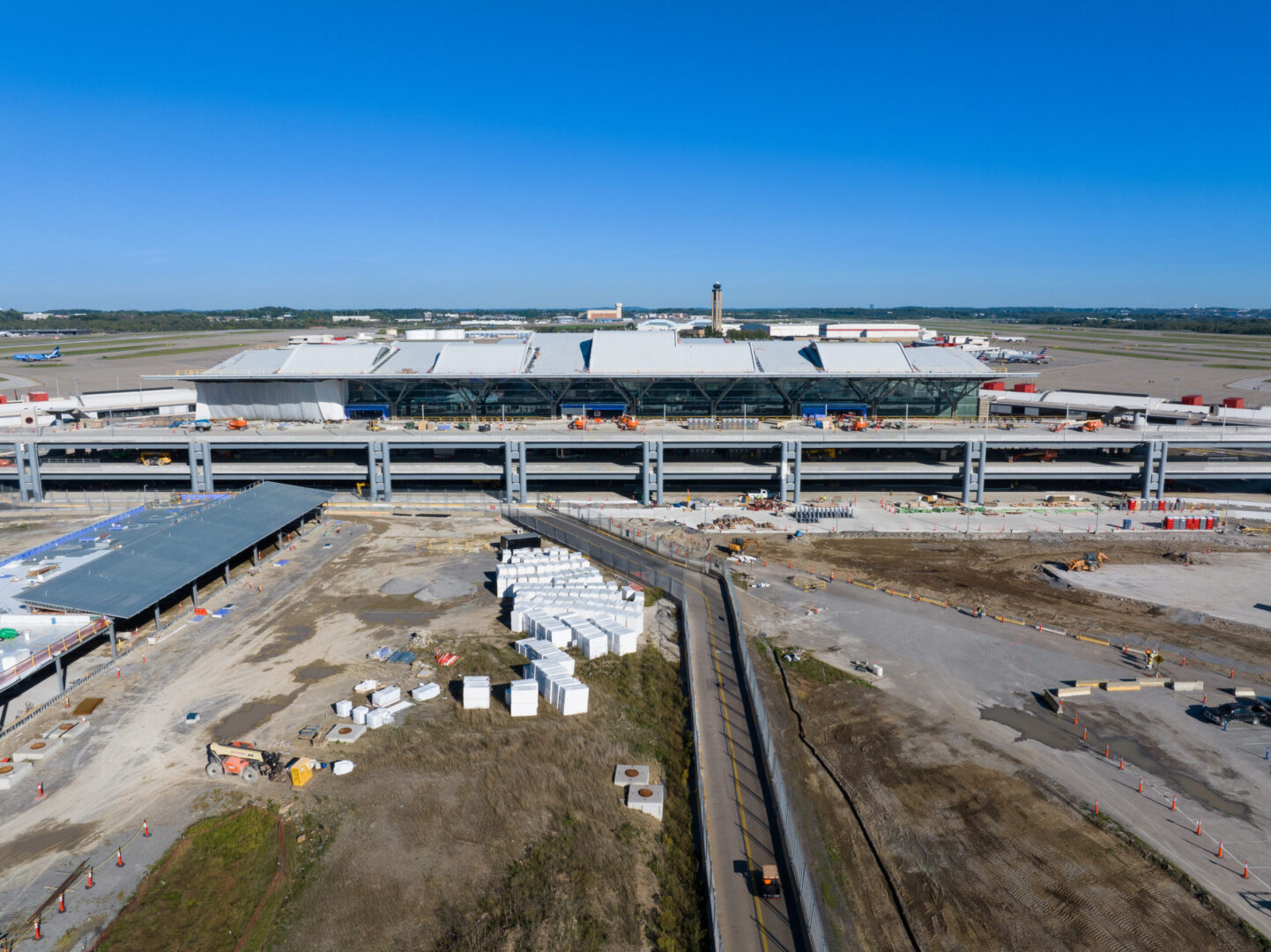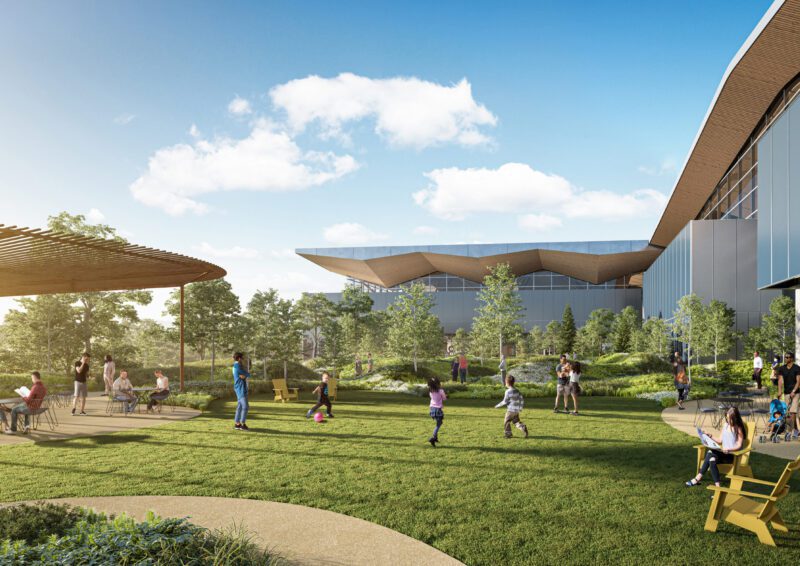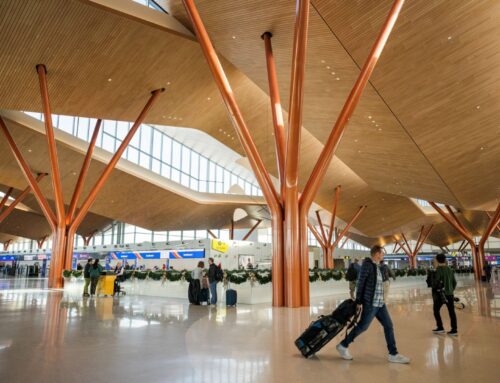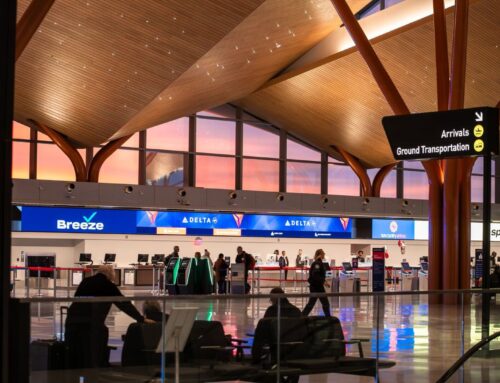A Pavilion in Penn’s Woods Part 1: Redefining an Airport Through Design
The future of Pittsburgh is here, starting with a vision realized by the new PIT terminal's design
By Gina Mastrangelo & Oscar Rzodkiewicz
Published October 21, 2024
Read Time: 6 mins

Editor’s Note: This story and video are the first of a two-part series showcasing the architectural design of Pittsburgh International Airport’s new terminal.
Pittsburgh is in the midst of a renaissance defined by emerging neighborhoods, an influx of new residents – and a state-of-the-art airport nearly ready to welcome them home.
The Steel City, although a beloved nickname for Pittsburgh, is now a misnomer. No longer defined by its steel industry, Pittsburgh has become a hub for robotics and technology, sparking new products and services that reach well beyond the region.
“If you take a look at the innovation that has come out of this community way back in history, that has impacted the whole world,” said PIT CEO Christina Cassotis. “And we intend to see that happen again through the lens of aviation and what we can do for that industry.”
Pittsburgh International Airport’s new terminal building will open in 2025. Construction workers have been working since 2021 to build it, but the new terminal’s story began long before the construction site existed.
In order to realize a new PIT, key players from the region came together to design an airport that better serves its primary audience: the people of Pittsburgh.
The structure is intended to be the airport Pittsburgh deserves, displaying the beauty, innovation and community that make the region special.
“Pittsburgh has been very humble, and it’s time to be a little less humble,” Cassotis said. “We’re going to do that through the building itself.”
An overnight shift
Twenty years ago, when US Airways pulled its hub from PIT, the airport went from serving connecting travelers – most never to leave the confines of the airside terminal except to board their flight – to serving mainly origin- and-destination passengers, people beginning or ending their journey in Pittsburgh.
Despite that huge shift, the airport’s infrastructure did not change. Pittsburgh passengers were forced to fly through an airport that was not designed for them – a problem the team at PIT knew they needed to solve.
The answer? A new, state-of-the-art airport.
“This facility we’re in today was designed to be US Airways’ airport,” said Paul Hoback, Chief Development Officer at ACAA. An airport team member since 2000, Hoback has been involved in the new terminal program since its beginnings.
“We wanted to make sure that this was Pittsburgh’s airport,” Hoback said.
The master planning process started with an idea on the back of a napkin.
Jeff Fagan, a former CEO of Dallas-Fort Worth International Airport (DFW), suggested moving the landside terminal building, an idea he illustrated for Cassotis on the back of a napkin. That idea eventually became the blueprint for the PIT’s terminal modernization.
From there, it was time to select architects that could translate Pittsburgh’s story into a design.
Ultimately, PIT turned a competition into a partnership, selecting both Gensler, HDR and Luis Vidal + Architects, firms whose visions for the new airport complemented each other perfectly. Their competitive partnership led to translating the PIT team’s ambitious vision into reality.
“There was conflict,” Hoback said. “What it created was an environment where people were competing with each other and pushing the design up to new heights and elevating that design continuously.”

The design of PIT’s new terminal was created to better effectively serve origin-and-destination traffic, a change from the airport’s previous role as a major connecting hub. (Courtesy of Gensler, + HDR in association with luis vidal architects)
Reintroducing Pittsburgh to the world
From the beginning, the PIT team was heavily involved in the design process.
“They set out a very extraordinary vision around right-sizing the airport and have picked the right team, the right people to help them develop something quite unique in the North American market,” said Barry Weekes, former Design Director at London Heathrow Airport.
To create the future of the region, the design team first had to understand the history of Pittsburgh – a rich culture borne from decades of hard work and dedication.
Although Pittsburgh’s past featured coal, steel and smoke, the present and future look very different.
“We wanted to showcase the innovation that’s emerging in Pittsburgh,” said Bill Flanagan, Special Advisor, Allegheny Conference on Community Development. “We wanted to get a feel for how the future is being invented here.”
And few people know Pittsburgh’s history better than Andy Masich, President and CEO of the Senator John Heinz History Center in Pittsburgh.
“Pittsburgh is about making things and building things and innovation,” said Masich. “That’s at the heart of what makes us Americans.”
In fact, out-of-town designers were shocked to see the natural landscape Pittsburgh has to offer. Suddenly, the grays they thought represented Pittsburgh became lush greenery. The old-fashioned mindset was replaced by a culture of innovation.
“The architects involved in the new terminal design were very conscious, not just of the airport needs but the community needs and the region this airport sits in,” said Jim Jarvis, Senior Vice President at Ricondo & Associates. Jarvis is also an aviation consultant and expert on the project.
The design team also visited local Pittsburgh neighborhoods, discovering buildings in communities that have been a core part of the region for over 100 years.
“We didn’t want it all to be about innovation,” Flanagan said. “We wanted to make sure they had a grounding for what makes Pittsburgh, Pittsburgh.”
By immersing themselves in the rich landscape of Pittsburgh, the architecture teams’ ideas started to materialize. Suddenly, Pittsburgh’s past shaped its future.
The whole building will tell a story, Cassotis said. “It’s a story about the history, but also the future and where we’re going.”

A view of the future arrivals level of PIT’s new terminal that will include baggage claim and curbside pickup for arriving travelers. (Renderings courtesy of Gensler + HDR in association with luis vidal + architects)
Pittsburgh through and through
When the new PIT opens, it will represent the region that inspired it and serve the people that inhabit it. The building aims to elevate the passenger experience and serve the modern traveler.
“In one’s airport, wherever you live, you always look at that as an element of yourself,” said Rick Lee, Implementation Manager, Paslay Group, part of the terminal modernization team. “It represents your city, your region. This is going to change everything for Pittsburgh.”
The new airport will be part of the already thriving PIT ecosystem.
From the tree columns and constellation lighting introducing visitors to a new perspective and focus on bringing nature into the terminal, to the undulating roof design representing the rolling hills of Western Pennsylvania – every element of the new PIT works in harmony to create something that will leave its mark on the region and elevate the future of travel.
“Pittsburgh has been through so many lows over my lifetime, and it’s always rebounded. It’s a sign of resilience,” said Richard Belotti, PIT’s retired Vice President of Planning.
“I think what the aviation industry is going to do is look at Pittsburgh and say, ‘Wow, they’ve done it again.’”
ACAA staff members Rocco Pacella and Julie Bercik also contributed to this story.

The new PIT terminal will include two large outdoor terraces pre-security that will be filled with greenery and provide ample seating. (Courtesy of Gensler, + HDR in association with luis vidal architects)






